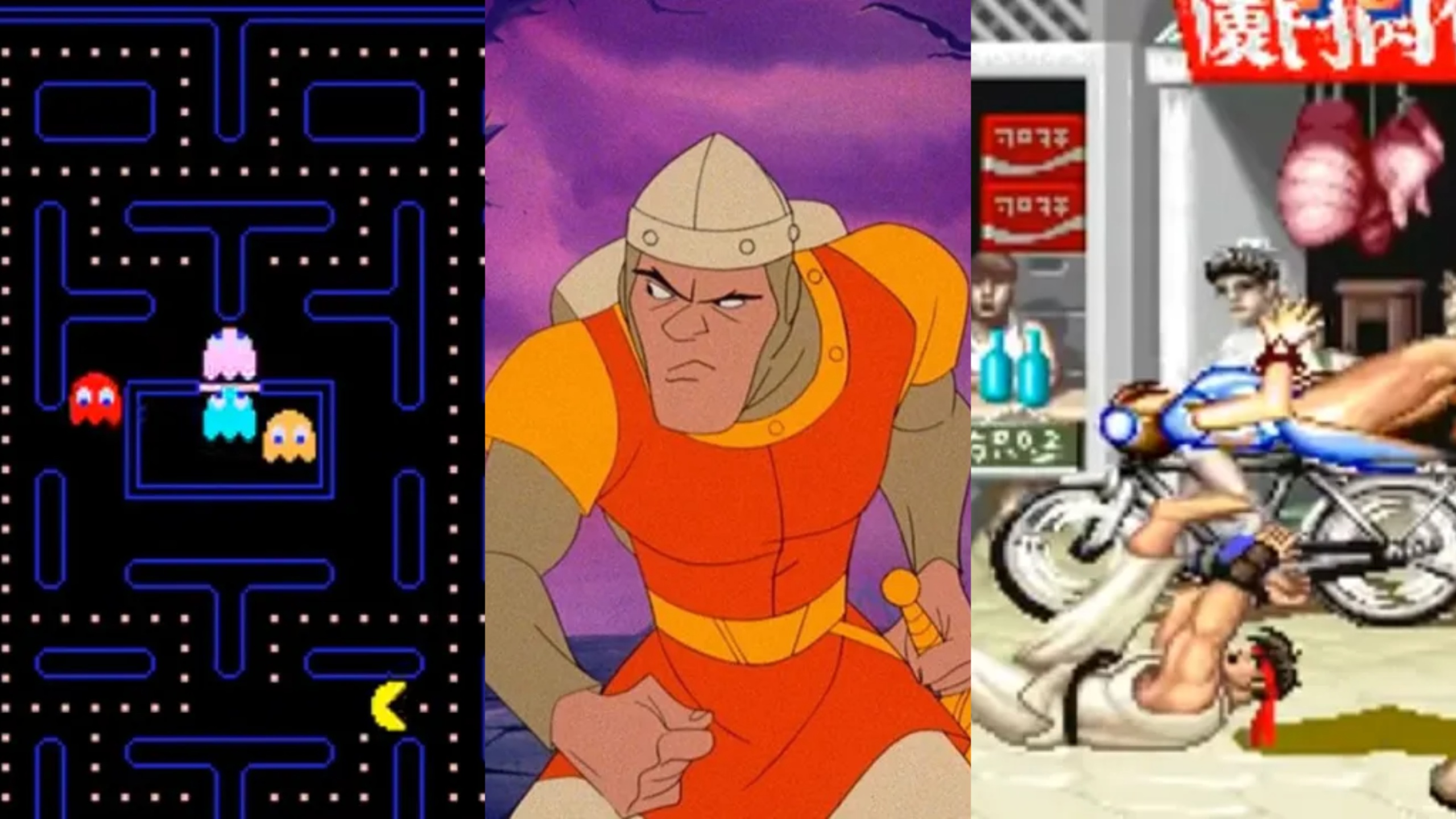
Long before video games were portable enough to fit inside your phone — or at the very least require a backpack to travel between houses — they were restricted to large, immobile cabinets known as arcade machines. Among the first video games, they barely resemble what most people these days associate with the modern idea of video games.
Yet, a quick look at the evolution of arcade games during that format’s golden days paints a very clear map from where we started to where we are now. From technological innovators to cultural disruptors, these are some of the most important arcade games ever made.
Computer Space (1971)
Every industry has to start somewhere. You can’t make a classic platformer like Super Mario Bros. without someone else making a less impressive platformer first. That’s where Computer Space comes in.
Computer Space launched in 1971, making it the first arcade video game ever commercially released. The game was the brainchild of Nolan Bushnell (best known for Atari and Chuck E. Cheese’s) back when he was an engineering student. Well, that’s actually only a half-truth. The game was really closer to a port of the computer game Spacewar! Its gameplay was simple: players controlled a lone rocket ship (represented by dots in the form of a spaceship) and tried to shoot down flying saucers (also represented by dots in the form of a UFO). However, since Computer Space predated analog sticks and d-pads, all the controls were relegated to buttons (which many players found difficult). Still, Computer Space demonstrated that you didn’t need a $10,000 computer to run Spacewar! Without the initial success of Computer Space, the arcade industry, and by extension the video game industry, might never have taken off.
Pong (1972)
While Computer Space was the first commercially available video game, Pong is sometimes popularly associated with that title. While that belief is factually incorrect, it is understandable. Pong wasn’t the first, but it did practically kickstart the entire video game industry.
Virtually everyone who has ever played a video game knows about Pong. Originally released in 1972, this arcade game consisted of two paddles knocking a ball around a black screen. A simple concept that also technically made Pong the world’s first arcade sports game due to its tennis-like structure, but an effective one. Pong went on to become yet another first: the world’s first commercially successful game. Not only did Atari sell hundreds of thousands of Pong arcade cabinets, but some of the first home consoles were just Pong clones. For all intents and purposes, the video game industry owes its very existence to Pong.
TV Basketball (1974)
Graphical fidelity is a major part of modern gaming. Thanks in no small part to the boastings of console manufacturers, gamers expect to explore ray-traced worlds at 60fps. Back in the early days of gaming, though, players were lucky to stare at a screen with simple lines and dots. That all changed with the invention of sprites.
In 1974, Taito released the game Basketball (or TV Basketball). In this title, two players controlled two on-screen characters each as they jumped and tried to score baskets. It was actually closer to a digital foosball table. While the concept was simple, Basketball set numerous precedents all at once. The game was arguably the first to use sprites instead of simple dots or lines, and since Basketball used these sprites to create semi-convincing images of humans, it also became the first game to utilize decidedly humanoid characters. Also, Basketball was the first basketball video game developed, hence its simple name.
Most important of all, Basketball set a precedent for licensing video games between Japan and North America. While Taito developed Basketball, Midway published it in the U.S. In a way, Basketball paved the way for some of the greatest arcade games of all time.
Gun Fight (1975)
There’s something magical about watching an old west gunfight. Some of the best shootouts in cinema history consisted of cowpokes taking potshots at one another with their irons. Plenty of video games feature Wild West gunfights, but they might never have existed if not for Gun Fight.
Not to be confused with Sega’s 1969 electro-mechanical arcade game Gun Fight, Midway’s Gun Fight, released in 1975, was a competitive shooter that pit players against one another. The goal was simple: shoot your opponent while dodging their bullets. What the game lacked in complexity (compared to modern titles) it made up for in technical prowess. Gun Fight was the first arcade game to use a microprocessor, which let it deliver better graphics than other arcade cabinets of its time. As with Basketball before it, Gun Fight helped Midway entrench itself in the arcade cabinet industry and transform into a video game juggernaut.
Breakout (1976)
Atari essentially started the video game boom thanks to its blockbuster title about batting a digital ball between two virtual paddles. It figures that Atari would find a way to recycle that concept and turn it into yet another success.
1976’s Breakout was a simple game that, like Pong before it, gave players control of a paddle and a ball. But unlike Pong, the goal was to launch the ball at a series of blocks and…well, break them. Lightning struck twice for Atari, as Breakout proved every bit as successful and addictive as Pong. But more importantly, Breakout helped create one of the computer industry’s most successful brands: Apple. Steve Wozniak (yes, the co-founder of Apple Computer Steve Wozniak) developed Breakout for Atari, and many of the features of Apple II, such as color graphics capabilities, were originally designed so Wozniak should show off Breakout running on the computer. Without Breakout, Apple might not be the industry juggernaut it is today.
Space Invaders (1978)
When you think of arcade games, the first image that probably comes to mind is a screen that shows all of the day’s high scores. The first arcade machines didn’t have the computing power to memorize those achievements, but when arcade cabinets reached that technological level, they gradually established that cultural concept.
Taito’s 1978 classic Space Invaders is the quintessential video game. The goal is as basic as shooting down invading alien ships, but that’s easier said than done since they get faster with each loss. Remarkably, that was actually a bug that became a feature since the game hardware had an easier time rendering fewer sprites on screen. Still, Space Invaders was wildly successful, thanks in no small part to its ability to save player high scores. Many people associate the game with kickstarting the golden age of video games and catalyzing the video game industry in general. It’s hard to disagree with that sentiment.
Galaxian (1979)
Television has been around for almost one century, and it took TV engineers around three decades to produce the first color TV broadcast. Video games went through a similar, if expedited, process.
Released in 1979, Galaxian was designed to be Namco’s answer to Space Invaders. Or, as Masaya Nakamura, then-President of Namco, put it, it was a “post-Invaders” game. Much like that title, Galaxian is a shoot-em-up where players fend off waves of aliens. However, since the game was released one year later than Space Invaders, Namco had a chance to improve on the formula. Galaxian has since gone down in history as the first arcade game to feature multicolored sprites, but that wasn’t Galaxian’s only improvement. Unlike Space Invaders, Galaxian included a scrolling background, and the enemy ships could fly in curved lines. Initiation is the best form of flattery, but Galaxian demonstrates that iteration is better still.
Pac-Man (1980)
You can’t judge a book by its cover, but you can judge a video game by one. Just looking at the box art of most games doesn’t tell you much, but if it sports a familiar character, you usually know what you’re getting into. We have Pac-Man to thank for that.
In 1980, Namco released the seminal maze-crawling, dot-munching classic Pac-Man. The goal, eat all the dots to finish a level, was simple as it was challenging and addictive. Not only did gamers love Pac-Man, but according to Time Magazine, the game amassed around $1 billion in quarters within its first year. Between its arcade cabinets, console ports, and sequels, the Pac-Man name went on earn well over $12 billion. While the Guinness World Records recognizes the game’s titular Pac-Man as the world’s first video game mascot, that award probably wouldn’t mean much had the game flopped.
Donkey Kong (1981)
Big things have small beginnings. You can’t get much bigger than the Super Mario franchise, and you can’t get much smaller than the arcade that started it all, Donkey Kong.
Almost everyone even slightly familiar with Super Mario knows the story of Donkey Kong. The game started when Shigeru Miyamoto and Gunpei Yokoi started work on converting the poorly performing Radar Scope into a more popular title. Originally, Yokoi wanted to make a title based on Popeye, but that idea fell through. As a Plan B, Miyamoto and Yokoi created the original characters of Jumpman, Lady, and Donkey Kong, who served as the prototypes of Mario, Paulina, and…Donkey Kong. The arcade game was officially released in 1981, and the rest is history. Donkey Kong went on to become one of the prototype platformer titles, amassed critical acclaim, and helped establish Nintendo as a video game juggernaut. Just goes to show you that failure can often eventually lead to success.
Pole Position (1982)
Many modern video games follow certain rules and conventions. Earlier games established these traditions, but only after even earlier titles tried their own rules that didn’t quite work.
1982’s Pole Position, was not the first racing arcade game ever made (let alone Namco’s first racing game), but it was Namco’s first title to feature 16-bit graphics. Moreover, the game introduced many racing game concepts that gamers take for granted, such as improving rewards for finishing in higher places, checkpoints, and qualifying laps. Unlike previous racing games, Pole Position also utilized a third-person camera, which gave players a better look at the action and the opportunity to marvel at the game’s graphics. Also, Pole Position was one of the first video games to receive a cartoon spin-off (even if the show had little to do with the actual game).
Dragon’s Lair (1983)
By the 1980s, the video game industry had started to harness the power of sprites, but even then, designers were limited in what they could portray. However, an ex-Disney animator demonstrated what developers could achieve if they thought outside the box.
Calling 1983’s Dragon’s Lair an arcade game might be a bit of an understatement. It was more like an arcade experience. Dragon’s Lair was one of the first games to use full-motion video (FMV) thanks to the power of Laserdisc. This technology, combined with the artistry of Don Bluth (creator of films such as The Land Before Time and The Secret of NIMH), created an addictive adventure starring the iconic Dirk the Daring. Admittedly, this graphical fidelity came at a cost, reducing gameplay to a glorified QTE, but fans didn’t care. Gamers still queued up in winding lines, and many people believe Dragon’s Lair helped give the then-waning game industry a much-needed shot in the arm. Dragon’s Lair demonstrates that in video games, presentation trumps everything else.
Gauntlet (1985)
Many video games these days revolve around cooperative multiplayer, especially if they focus on clearing dungeons. While not the first dungeon crawler to hit arcades, Gauntlet was probably the most important.
Released in 1985, Atari’s Gauntlet shook the arcade world as the industry’s first multiplayer dungeon crawler. Each run tasked players with finding the exit to dungeons drowning with enemies. This was a daunting if not impossible task solo, but the secret to Gauntlet’s success was its pioneering drop-in drop-out feature. With only a few quarters, allies could join in at any time to help. The ease of playing this game with others catered to the communal nature of the arcade experience and ushered in a wave of similar titles designed to encourage on-the-fly cooperation. Through that innovation, Gauntlet also helped popularize the four-player arcade multiplayer experience. Even Gauntlet’s cabinet design (which gave each player/character their own defined space) quickly became the standard for the industry.
While subsequent dungeon crawlers improved on this formula, Gauntlet still set a precedent for inventing the gameplay mechanic in the first place. You can’t iterate on something if nobody is willing to take the first steps.
Street Fighter II (1991)
Capcom tried to revolutionize the fighting genre with Street Fighter. It failed. The company needed to make a sequel before it produced a winning formula, but boy did Capcom succeed.
When most people think of “Street Fighter,” they think of the 1991 arcade title Street Fighter II: The World Warrior. This game introduced many concepts that are synonymous with fighting games these days, such as combos and six-button controls. Street Fighter II was a monumental success and essentially started the fighting game craze.
Street Fight II gave way to Street Fighter II: Champion Edition, Street Fighter II Turbo: Hyper Fighting, Super Street Fighter II, Super Street Fighter II Turbo, Hyper Street Fighter II, Super Street Fighter II Turbo: HD Remix, and Ultra Street Fighter II: The Final Challengers, as well as countless console ports. Even though Capcom has released plenty of sequels, Street Fighter II, specifically the Super Street Fighter II Turbo edition, is still played competitively to this day, which speaks volumes of its quality and importance.
Mortal Kombat (1992)
The success of Street Fighter II resulted in numerous clones aiming to swipe a piece of the game’s pugilism pie. Arguably the most influential and important was Mortal Kombat.
If Street Fighter II represented how Japanese studios approached the competitive fighting genre, then Mortal Kombat encapsulated how U.S. developers created fighting games; one focused on combos, the other on carnage. The first Mortal Kombat introduced players to a five-button control scheme, popularized the use of digitized sprites, and introduced audiences to the ultimate form of humiliation: Fatalities. What better way to solidify your victory than by ripping out your opponent’s spine?
In fact, Mortal Kombat was so violent that it eventually resulted in the formation of the Entertainment Software Rating Board (ESRB). What other video games can you think of that essentially created a non-profit regulatory organization?
Dance Dance Revolution (1998)
Most arcade games consist of simple cabinets with buttons and joysticks or lightguns, but rhythm games break the mold. Why ask players to cramp their fingers when you can make them work up a sweat by pounding keys while following a rhythm?
Konami’s Dance Dance Revolution, which was released in 1998 in Japan and overseas in 1999, is arguably the most famous rhythm game to ever hit arcades. At the time of release, DDR was a novel experience that tasked players with stomping their feet to the beat on different foot panels. The game was praised for its originality and marriage of video games and exercise. DDR has received countless sequels, clones, and ports. DDR fever is still going strong, and with songs like Speed Over Beethoven and Butterfly (no, not that Butterfly), it’s not hard to see why.
The post 15 Most Important Arcade Games Ever appeared first on Den of Geek.









